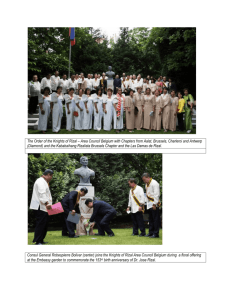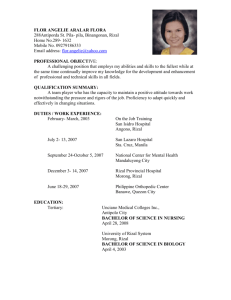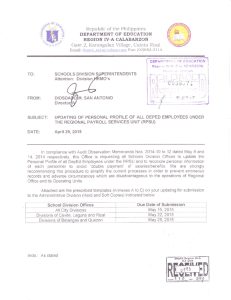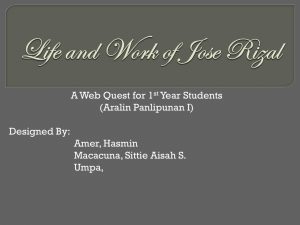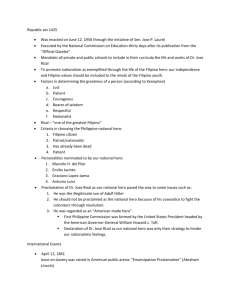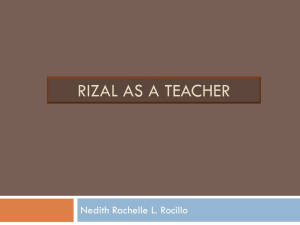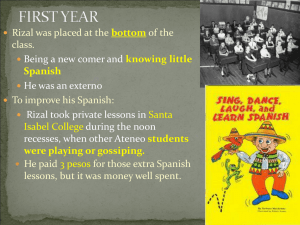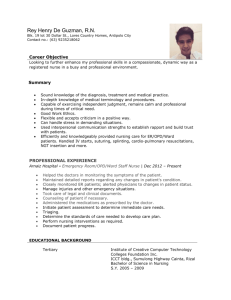Cover Story - Arizona Knights of Rizal
advertisement
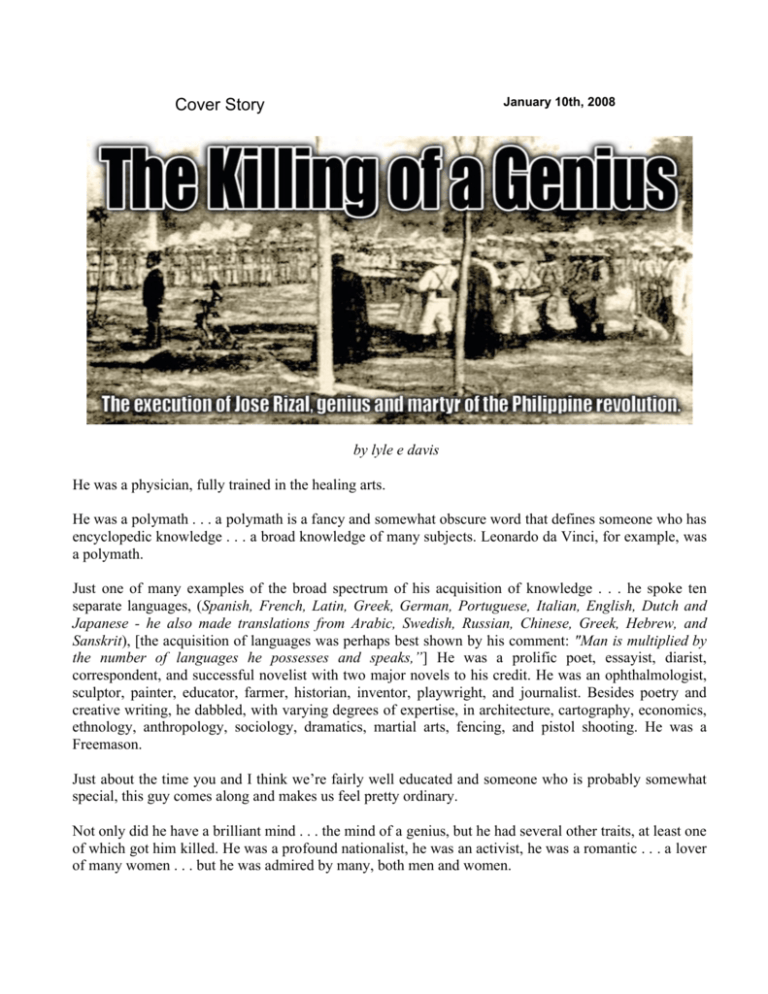
January 10th, 2008 Cover Story by lyle e davis He was a physician, fully trained in the healing arts. He was a polymath . . . a polymath is a fancy and somewhat obscure word that defines someone who has encyclopedic knowledge . . . a broad knowledge of many subjects. Leonardo da Vinci, for example, was a polymath. Just one of many examples of the broad spectrum of his acquisition of knowledge . . . he spoke ten separate languages, (Spanish, French, Latin, Greek, German, Portuguese, Italian, English, Dutch and Japanese - he also made translations from Arabic, Swedish, Russian, Chinese, Greek, Hebrew, and Sanskrit), [the acquisition of languages was perhaps best shown by his comment: "Man is multiplied by the number of languages he possesses and speaks,”] He was a prolific poet, essayist, diarist, correspondent, and successful novelist with two major novels to his credit. He was an ophthalmologist, sculptor, painter, educator, farmer, historian, inventor, playwright, and journalist. Besides poetry and creative writing, he dabbled, with varying degrees of expertise, in architecture, cartography, economics, ethnology, anthropology, sociology, dramatics, martial arts, fencing, and pistol shooting. He was a Freemason. Just about the time you and I think we’re fairly well educated and someone who is probably somewhat special, this guy comes along and makes us feel pretty ordinary. Not only did he have a brilliant mind . . . the mind of a genius, but he had several other traits, at least one of which got him killed. He was a profound nationalist, he was an activist, he was a romantic . . . a lover of many women . . . but he was admired by many, both men and women. Born to a middle class family in the Philippines, attended the Ateneo Municipal de Manila, earning a Bachelor of Arts degree, summa cum laude. He enrolled in the University of Santo Tomas Faculty of Medicine and Surgery and the University of Santo Tomas Faculty of Philosophy and Letters and then traveled alone to Madrid, Spain, where he studied medicine at the Universidad Central de Madrid, earning the degree of Licentiate in Medicine. He attended the University of Paris and earned a second doctorate at the University of Heidelberg. Unfortunately, he also became a martyr. So why did they kill him? What is it about this human condition of ours that winds up taking the life of a man who did so much good, and could have done even more good? Who had so much to offer the world as well as his own community? And at such a young age? You and I are probably not all that familiar with the name, Jose Rizal. Ask any Filipino and they’ll know. In many ways, Jose Rizal was the equivalent of our George Washington, with a dash of Abraham Lincoln thrown in as well. He is considered a national hero, and the anniversary of Rizal's death is commemorated as a Philippine holiday called Rizal Day. He is a martyr of the Philippine Revolution. “But what do I care of The Philippines?” you may say. “And what do I care about a long dead man who went and got himself killed because he believed in a cause?” Because if it happened there it could happen here as well. And the idiocy of governments and legislators is not, and never has been, confined to far off countries. It might help to know a little of the Jose Rizal story. He was the seventh of eleven children born to a middle class family in the town of Calamba, Laguna, Philippines. José Rizal's parents were prosperous farmers who were granted lease of a hacienda and an accompanying rice farm by the Dominicans, who, in this highly Catholic country, essentially had become the ruling class. Rizal was a 6th-generation descendant of Domingo Lam-co, a Chinese immigrant entrepreneur who sailed to the Philippines from Jinjiang, Quanzhou, China, in the mid-17th century. To free his descendants from the anti-Chinese animosity of the Spanish authorities, Lamco changed the family surname to the Spanish surname "Mercado" (market) to indicate their Chinese merchant roots. Their original application was for the name "Ricial," apropos of their main occupation of farming, which was arbitrarily denied. The name "Rizal" (originally Ricial, the green of young growth or green fields), was adopted by Jose to enable him to travel freely as the Mercado name had gained notoriety by earlier links with Filipino priests who were sentenced to death, by garotte, as subversives. Death by garotte is a particularly interesting form of execution. Basically, the executioner affixes a rope or chain around the neck of the condemned and tightens it until death arrives by suffocation, usually painfully and slowly. Execution by garotte was not done away with in Spain, who was, essentially, the overseer of the Philippines, until March 1974. In 1990 the country of Andorra was the last country in the world to outlaw it. Inflamed by the execution of the priests, it began in early childhood that Jose and his brother, Paciano, were already advancing unheard-of political ideas of freedom and individual rights which infuriated the authorities. The authorities didn’t exactly help quell this fury. Jose always retained the memory as a ten-year old of his mother's treatment at the hands of the civil authorities, with the approval of the Church prelates. The incident stemmed from an accusation that Rizal's mother, Teodora, tried to poison the wife of a cousin when she claimed she only intervened to help. Without a hearing she was ordered to prison in Santa Cruz in 1871, and made to walk the ten miles from Calamba. She was released after two and a half years of appeals to the highest court. A Garotte Executiion Device In spite of the deep seated emotions against the authorities for these terrible incidents, Jose still advocated peaceful reform. He counseled against violence. Yet, ironically, he would wind up being executed, charged, unfairly, with being an activist and part of the building resentment against the government and church authorities. He would be credited, or more correctly, his execution would be credited , with being the catalyst that began the Philippine Revolution. An execution by Garotte, 1901 After becoming an adult, Jose’ Rizal had become a political figure. He was the founder of La Liga Filipina, a civic organization that subsequently gave birth to the Katipunan led by Andres Bonifacio, a Filipino revolutionary leader and a rebel leader considered to be the father of the Philippine Revolution against Spain and Emilio Aguinaldo, the first and youngest Filipino President. Rizal’s life is well documented, partly because he was such a prolific writer. There are many accounts of his travels and his views . . . his thoughts. They were included in his later trips as well, home and back again to Europe through Japan and the United States, and, finally, through his sef-imposed exile in Hong Kong. This period of his education and his frenetic pursuit of life included his recorded affections, for in addition to his brilliant mind, Joe Rizal was also a charmer of the ladies. Jose Rizal Among them were Gertrude Becket of London, wealthy and high-minded Nelly Boustead of the English and Iberian merchant family, a descendant of a noble Japanese family, Usui Seiko, his earlier friendship with Segunda Katigbak, and an eight-year romantic relationship with his cousin, Leonor Rivera (see a crayon sketch of her, by Rizal, to the right). His European friends kept almost everything he gave them, including doodlings on pieces of paper. In the home of a Spanish liberal, Pedro Ortiga y Perez, he left an impression that was to be remembered by his daughter, Consuelo. In her diary, she wrote of a day Rizal spent there and regaled them with his wit, social graces, and sleight-of-hand tricks. In London, he became a regular guest in the home of Dr. Reinhold Rost of the British Museum who referred to him as "a gem of a man." José Rizal's most famous works were his two novels, Noli me Tangere (Touch Me Not) and El Filibusterismo (The Subversive). These writings angered both the Spaniards and the hispanicized Filipinos due to their insulting symbolism. They are highly critical of Spanish friars and the atrocities committed in the name of the Church. A crayon sketch by Rizal of his cousin/paramour, Leonor Rivera Rizal's first critic was Ferdinand Blumentritt, a Sudetan-German professor and historian whose first reaction was of misgiving. Blumentritt was the grandson of the Imperial Treasurer at Vienna and a staunch defender of the Catholic faith. This did not dissuade him, however, from writing the preface of El Filibusterismo after he had translated Noli me Tangere into German. Noli was published in Berlin (1887) and Fili in Ghent (1891) with funds borrowed largely from Rizal's friends. As Blumentritt had warned, these led to Rizal's prosecution as the inciter of revolution and eventually, to a military trial and execution. The intended consequence of teaching the natives where they stood brought about an adverse reaction, as the Philippine Revolution of 1896 took off virulently thereafter. As a leader of the reform movement of Filipino students in Spain, he contributed essays, allegories, poems, and editorials to the Spanish newspaper La Solidaridad in Barcelona. The core of his writings centered on liberal and progressive ideas of individual rights and freedom; specifically, rights for the Filipino people. He shared the same sentiments with members of the movement: that the Philippines is battling, in Rizal's own words, "a double-faced Goliath"-- corrupt friars and bad government. His agenda included: • That the Philippines be a province of Spain • Representation in the Courts: • Filipino priests instead of Spanish friars • Freedom of assembly and speech • Equal rights before the law (for both Filipino and Spanish plaintiffs) The colonial authorities in the Philippines did not favor these reforms even if they were more openly endorsed by Spanish intellectuals. Upon his return to Manila in 1892, he formed a civic movement called La Liga Filipina (The Filipina League). The league advocated these moderate social reforms through legal means, but was disbanded by the governor. At that time, he had already been declared an enemy of the state by the Spanish authorities because of the publication of his novels. Persecutions After writing Noli me Tangere, among the numerous other poems, plays and tracts he had already written, he gained further notoriety with the Spaniards. Against the advice of relatives and friends, he came back to the Philippines to aid his family which was in dispute with the Dominican landlords. In 1887, he wrote a petition on behalf of the tenants of Calamba and later that year led them to speak out against friar attempts to raise rent. They initiated a litigation which resulted in the Dominicans evicting them from their homes, including the Rizal family. Eventually, General Valeriano Weyler had the buildings on the farm torn down. In 1896 while Rizal was in prison in Fort Santiago, his brother Paciano was tortured by Spaniards trying to extract evidence of Jose's complicity in the revolution. Two officers took turns applying pins under Paciano's fingernails; with his hands bound behind him and raised several feet, he was dropped repeatedly until he lost consciousness. Exile in Dapitan Rizal was implicated in the activities of the beginning rebellion and in July 1892, was deported to Dapitan in the province of Zamboanga. There he built a school, a hospital and a water supply system, and taught and engaged in farming and horticulture. The boys' school, in which they learned English, considered a weird option then, was conceived by Rizal. Many of his students would later enjoy successful lives as farmers and honest government officials. As a gift to his mother on her birthday he wrote the other of his poems of maturity, "Mi Retiro," with a description of a calm night overlaid with a million stars. The poem, with its concept of a spontaneous creation and speaking of God as Plus Supra, is considered his accommodation of evolution. ...the breeze idly cools, the firmament glows, the waves tell in sighs to the docile wind timeless stories beneath the shroud of night. Say that they tell of the world, the first dawn of the sun, the first kiss that his bosom inflamed, when thousands of beings surged out of nothing, and peopled the depths, and to the heights mounted, to wherever his fecund kiss was implanted. Those four years of his exile coincided with the development of the Philippine Revolution from inception and to its final breakout which, from the viewpoint of the court which was to try him, suggested his complicity in it. He condemned the uprising, although all the members of the Katipunan made him honorary president and used his name as a war-cry. Near the end of his exile he met and courted the stepdaughter of a patient, an Irishwoman named Josephine Bracken. He was unable to obtain an ecclesiastical marriage because he would not return to the religion of his youth and was not known to be clearly against revolution. He nonetheless considered Josephine to be his wife and the only person mentioned in the poem, Farewell, sweet stranger, my friend, my joy...[ By 1896, the rebellion fomented by the Katipunan, a militant secret society, had become a full blown revolution, proving to be a nationwide uprising and leading to the proclamation of the first democratic republic in Asia. To dissociate himself, Rizal volunteered and was given leave by the Spanish Governor General Ramon Blanco to serve in Cuba to minister to victims of yellow fever. Josephine Bracken Before he left Dapitan, he issued a manifesto disavowing the revolution and declaring that the education of Filipinos and their achievement of a national identity were prerequisites to freedom. Rizal was arrested en route, imprisoned in Barcelona, and sent back to Manila to stand trial. He was implicated in the revolution through his association with members of the Katipunan and was to be tried before a court-martial for rebellion, sedition, and conspiracy. During the entire passage, he was unchained, no Spaniard laid a hand on him, and had many opportunities to escape but refused to do so. Rizal was convicted on all three charges and sentenced to death. Governor General Blanco, who was sympathetic to Rizal, had been forced out of office, and the friars had placed a political puppet in his stead, sealing Rizal's fate. His poem, undated and believed to be written on the day before his execution, was hidden in an alcohol stove and later handed to his family with his few remaining possessions, including the final letters and his last bequests. Within hearing of the Spanish guards he reminded his sisters in English, "There is something inside it," referring to the alcohol stove which was to be returned after his execution, thereby emphasizing the importance of the poem. This instruction was followed by another, "Look in my shoes," in which another item was secreted. Exhumation of his remains in August 1898, under American rule, revealed he had been uncoffined, his burial not on sanctified ground granted the 'confessed' faithful, and whatever was in his shoes had disintegrated. Jose Rizal’s Photo on the day of his execution In his letter to his family he wrote: "Treat our aged parents as you would wish to be treated ... Love them greatly in memory of me ... 30 December 1896." In his final letter, to the Sudeten-German professor Ferdinand Blumentritt - “Tomorrow at 7, I shall be shot; but I am innocent of the crime of rebellion ..." He had to reassure him that he had not turned revolutionary as he once considered being, and that he shared his ideals to the very end. He also bequeathed a book personally bound by him in Dapitan to his 'best and dearest friend.' When Blumentritt received it he broke down and wept. In the early morning of 30 December 1896, Rizal walked to his place of execution, flanked by two Jesuits, Father Jose Vilaclara, one of his professors, and Father Estanislao March, whom he had known in his student days. He marched briskly, with calmness and dignity. Moments before his execution by a firing squad of Filipino native infantry, backed by an insurance force of Spanish troops, the Spanish surgeon general requested to take his pulse; it was normal. Aware of this, the Spanish sergeant in charge of the backup force hushed his men to silence when they began raising 'vivas!' with the partisan crowd. His last words were "consummatum est",--it is finished. Rizal Park A monument, with his remains, now stands at the place where he fell, designed by the Swiss Richard Kissling of the famed William Tell sculpture. The statue carries the inscription: I want to show to those who deprive people the right to love of country, that when we know how to sacrifice ourselves for our duties and convictions, death does not matter if one dies for those one loves – for his country and for others dear to him. 'Retraction' controversy That his burial was not on holy ground led to issues raised on the veracity of accounts of his 'retraction,' which the Church ever since has been vigorously defending. Many continue to believe that Rizal neither married his sweetheart Josephine Bracken in Roman Catholic rites hours before his execution nor ever retracted those parts of his writings that were anti-Roman Catholic. Rizal Monument Those who deny the retraction point out to a revealing clue tucked in 'Adios', “I go where there are no slaves, no hangmen or oppressors, where faith does not kill ...” Whether this stanza was his final comment on the Catholic Church is a subject of dispute. In most of his writings Rizal maintained that the men of the cloth were the real rulers and the real government. Much of the Church's case rests on claims of a signed retraction, a copy of which could not be produced and shown to the Rizal family despite their repeated requests. In the same tenor, Rizal condemned the uprising when Bonifacio asked for his support. Bonifacio, in turn, openly denounced him as a coward for his refusal. Rizal believed that an armed struggle for independence was premature and ill-conceived. Rizal never held a gun or sword in the battlefield to fight for freedom. This fact leads some to question his ranking as the nation's premier hero, with a few who believe in the beatification of Bonifacio in his stead. In his defense, the historian, Rafael Palma, contends that the revolution of Bonifacio is a consequence wrought by the writings of Rizal and that although the sword of Bonifacio produced an immediate outcome, the pen of Rizal generated a more lasting achievement. Rizal's advocacy of institutional reforms by peaceful means rather than by violent revolution makes him Asia's first modern non-violent proponent of political reforms. Forerunner of Gandhi and contemporary of Tagore and Sun Yat Sen, all four created a new climate of thought throughout Asia, leading to the attrition of colonialism and the emergence of new Asiatic nations by the end of World War II. Such was recognized by Gandhi who regarded him as a forerunner in the cause of freedom. Jawaharlal Nehru, in his prison letters to his daughter Indira, acknowledged Rizal's significant contributions in the Asian freedom movement. These leaders regarded these contributions as keystones and acknowledged Rizal's role in the movement as foundation layer. Republic Act 1425 was passed in 1956 by the Philippine legislature that would include in all high school and college curricula a course in the study of his life, works and writings. The wide acceptance of Rizal is partly evidenced by the countless towns, streets, and numerous parks in the Philippines named in his honor. Monuments in his honor were erected in Madrid, Spain,Wilhelmsfeld, Germany, Jinjiang, Fujian, China; in America, at Chicago, San Diego, and Seattle. Many poetic titles were bestowed on him: "Pride of the Malay Race," "the First Filipino," "Greatest Man of the Brown Race," among others. The Order of the Knights of Rizal, a civic and patriotic organization, boasts of dozens of chapters all over the globe . “He who knows the surface of the earth and the topography of a country only through the examination of maps…is like a man who learns the opera of Meyerbeer or Rossini by reading only reviews in the newspapers. The brush of landscape artists Lorrain, Ruysdael, or Calame can reproduce on canvas the sun's ray, the coolness of the heavens, the green of the fields, the majesty of the mountains...but what can never be stolen from Nature is that vivid impression that she alone can and knows how to impart--the music of the birds, the movement of the trees, the aroma peculiar to the place--the inexplicable something the traveller feels that cannot be defined and which seems to awaken in him distant memories of happy days, sorrows and joys gone by, never to return.--Rizal, "Los Viajes" Source: The Paper 3643 Grand Avenue, Suite B San Marcos, Ca. 92069 Voice (760) 747-7119 Fax: (760) 741-7800 Classified: (760) 497-4281 Email: thepaper@cox.net; website: www.thecommunitypaper.com Editor/Publisher: Lyle E. Davis; Associate Publisher: Evelyn Madison Business Manager: Evelyn Madison; Classified Ads: Eric Wormser Art Director: Troy T. Larson; Legal Commentary: John Smylie
